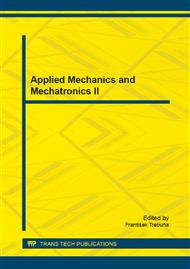p.31
p.35
p.43
p.49
p.54
p.63
p.69
p.76
p.88
Contact Problems between the Hub and the Shaft with a Four-Angular Shape of Cross-Section for Different Angular Positions
Abstract:
The works [1, 2] present the values of the force and moment of friction needed to disassemble the axisymmetric connection with oval and three-angular shape of cross-section of the shaft. These works additionally show the variable values of the Mises stresses and contact pressures. This paper presents research which is a continuation of the research program on the evaluation of the influence of cross-section deviations, radial deviations, and their compilations on the value of the contact area in the connection. The limited contact area has a decisive impact on functional and operational parameters of the connection. Point contact between the shaft and the hole is the reason of the reduction of load transmission. The paper concerns the connection between the shaft with four-angular shape of cross-section with the deviation Tw = 13 μm and the hub with the nominal roudness. The authors have proved the occurrence of variable values of the force and moment of friction during disassembling of the connection. The authors have also showed the occurrence of variable values of the reduced stresses and contact pressures.
Info:
Periodical:
Pages:
54-62
Citation:
Online since:
November 2015
Authors:
Keywords:
Price:
Сopyright:
© 2015 Trans Tech Publications Ltd. All Rights Reserved
Share:
Citation:


